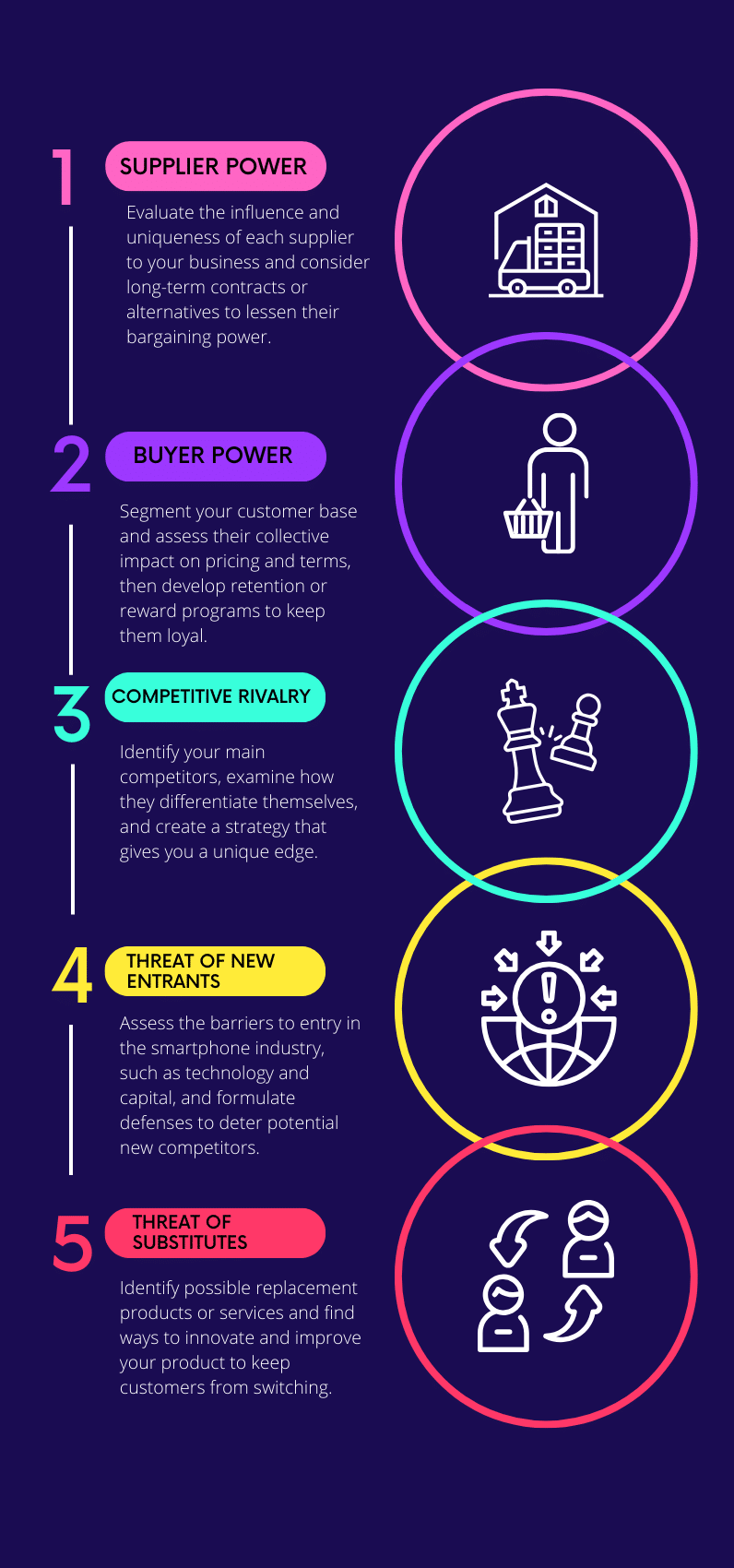Understanding competitive forces is crucial for effective strategic business planning, and employing Porter’s Five Forces template can streamline this vital process. Porter’s Five Forces framework serves as a robust mechanism for evaluating the external market environment.
By identifying and dissecting five unique competitive forces that shape every industry, this model equips businesses with critical data to recognize their market strengths and vulnerabilities. Especially in an era marked by complicated market dynamics, a mere superficial overview of the competitive landscape is insufficient for sustained success.
Businesses must delve deeper into understanding the external factors that can impact their operations and profitability. Porter’s Five Forces model offers a nuanced approach to examining these variables, thus forming an essential part of any competitive landscape analysis.
This comprehensive guide is designed for business owners, startups, entrepreneurs, and professionals involved in strategic planning. It provides an exhaustive analysis of Porter’s Five Forces and includes actionable steps for carrying out your own assessment. To facilitate the real-world application of this framework, a ready-to-use template is included.
As part of our commitment to offering complete insights into strategic planning, a FAQ section will address common queries regarding the utility and limitations of this model.
If you are a startup specifically looking to conduct market research, our previous post on how to do market research for a startup in 2023 could serve as an excellent preliminary read.
In summary, this article aspires to be an all-encompassing resource for those interested in integrating Porter’s Five Forces framework into their business strategy.
The Genesis of Porter’s Five Forces

The concept of Porter’s Five Forces was introduced in 1979 by Michael E. Porter, a professor at Harvard Business School. It was initially published in a book titled “Competitive Strategy: Techniques for Analyzing Industries and Competitors.” Porter’s objective was to offer a framework that would help businesses understand the structure of their industry in a way that would facilitate more effective strategic decision-making. The model quickly gained traction and has since become a cornerstone in the field of business strategy and management.
Over the years, Porter’s Five Forces has been integrated into both academic curricula and business practices worldwide. Its applicability ranges from high-level strategic planning to more focused market analyses.
According to numerous case studies and empirical evidence, businesses that employ this framework can better understand market forces, predict trends, and develop strategies to enhance competitive advantage. This timeless model has been the subject of countless adaptations, interpretations, and extensions, testifying to its lasting relevance in the dynamically evolving business landscape.
Its practicality and effectiveness have made it an essential component of any serious competitive analysis. Moreover, its utility in conducting market research, especially for startups, further extends its range of applications.
Breaking Down the Five Forces
The utility of Porter’s Five Forces lies in its ability to focus on five critical areas that shape the competitive environment of any industry. These five forces play pivotal roles in determining a firm’s profitability and strategic options. Let’s delve deeper into why each force is vital:
- Supplier Power: When suppliers have more power, they can demand higher prices for their goods or services, directly affecting your cost structure and profitability. High supplier power can also mean fewer alternatives for businesses, potentially leading to supply chain vulnerabilities.
- Buyer Power: In contrast, when buyers have the upper hand, they can demand better service, higher quality, or lower prices. High buyer power can squeeze profit margins, especially in highly competitive industries. Understanding this force can help businesses devise strategies to increase customer loyalty.
- Competitive Rivalry: This is often the most visible force. High levels of rivalry can lead to price wars, aggressive marketing, and innovation. While competition can stimulate business improvement, it can also diminish profitability if not managed wisely.
- Threat of New Entrants: New entrants bring new capacity and a desire to gain market share, often disrupting established business models. The easier it is for newcomers to enter the market, the more established companies may have to lower prices or increase spending on marketing and innovation to defend their position.
- Threat of Substitutes: This force focuses on the potential for customers to find a different way of doing what your product does. For example, video calls substitute for travel in business settings, or renewable energy stands in for fossil fuels. The more viable substitutes available, the more a company’s pricing power and profitability can be limited.
Understanding each of these forces in the context of your industry can provide a nuanced view of the competitive landscape. It enables you to anticipate shifts, prepare for challenges, and create strategies that position your business for success.
How to Conduct Porter’s Five Forces Analysis

Conducting a Porter’s Five Forces Analysis may seem daunting, but with the right Porter’s Five Forces template, it’s a straightforward process when broken down into steps.
Here’s a detailed guide to walk you through each stage:
- Define the Industry: The first step involves clearly defining the industry or market segment you wish to analyze. Consider factors like geographic reach, market size, and the range of products or services included.
- Gather Data: Collect relevant data from a variety of sources like market reports, academic studies, and industry publications. Data is crucial for providing a quantitative backbone to your analysis.
- Identify Key Players: Make a list of main suppliers, buyers, competitors, and potential substitutes. Understanding who the key players are will set the stage for the analysis.
- Analyze Supplier Power: Evaluate how many suppliers exist, how unique their services or products are, and how much it would cost to switch from one supplier to another. High supplier power can limit your ability to lower costs.
- Analyze Buyer Power: Assess the concentration of buyers, their size, and their importance to your business. High buyer power might require you to improve product quality or customer service.
- Assess Competitive Rivalry: Study the number of competitors, their strengths and weaknesses, and the overall demand in the market. A high level of competition could force you to innovate more quickly and keep prices low.
- Evaluate Threat of New Entrants: Examine factors like initial capital requirements, customer loyalty, and access to distribution channels. Barriers to entry will protect your market share.
- Consider Threat of Substitutes: Analyze the availability of alternative products or services and how they compare in terms of price, quality, and convenience. This will help you anticipate whether customers could switch to substitutes and how that would affect your business.
- Draw Conclusions: With all forces analyzed, you can now draw conclusions about the overall competitiveness and attractiveness of the industry or market segment. This informs strategic decisions like market entry, product development, and pricing strategies.
- Implement Strategies: Based on your analysis, develop strategies that capitalize on strengths, mitigate weaknesses, exploit opportunities, and defend against threats.
Common Mistakes to Avoid:
While Porter’s Five Forces is a powerful tool, certain pitfalls can undermine its effectiveness. Here are some common mistakes to watch out for:
- Overgeneralizing the Industry: Too broad a definition can dilute the insights gained. Make sure to narrow your focus to a market segment where the analysis is most relevant.
- Relying Solely on Public Information: While public sources are a good starting point, they may not offer the most current or comprehensive data. Try to supplement them with firsthand research wherever possible.
- Ignoring Changes Over Time: Market conditions and competitive forces are dynamic. An analysis is only a snapshot in time, so it’s advisable to update it regularly to adapt to changing circumstances.
- Neglecting Internal Factors: While the model focuses on external forces, internal capabilities, and resources are crucial for determining how well a business can meet these external challenges.
- Using the Analysis in Isolation: Porter’s Five Forces should be one part of a broader strategic analysis. It’s most effective when used in conjunction with other tools and frameworks, like a SWOT analysis or a PESTLE analysis.
By understanding and avoiding these common mistakes, you can ensure a more accurate and useful Five Forces analysis.
Porter’s Five Forces Template
A practical Porters Five Forces template can streamline the process of conducting Porter’s Five Forces analysis, turning it from a daunting task into a manageable one. Once you have the template, here’s how to make the most of it:
- Preparation: Before you begin, compile all the necessary data, reports, and industry insights. Make sure you’re not going in blind.
- Fill in the Basics: Start by defining the industry and listing your data sources to ensure your findings are grounded in fact.
- Key Players: Populate the table or chart with the names and categories of the key players you’ve identified.
- Force-by-Force Analysis: Work through each of the Five Forces one at a time. Take detailed notes, and if you’re using a scoring system, assign scores based on the data you’ve gathered.
- Summarize: After completing the force-by-force analysis, take some time to summarize your findings. What does this mean for your business?
- Strategic Action: Use the insights gained to note down potential strategies in the ‘Strategic Recommendations’ section. These can be immediate actions or long-term strategies.
- Regular Updates: Finally, set reminders for when you should review and update this analysis. The market doesn’t stand still, and neither should your strategic planning.
Having a structured Porter’s five forces template can make the complex task of conducting the analysis much simpler, more organized, and ultimately more useful.

Implementing the Analysis Into Your Business Strategy
After completing your Porter’s Five Forces analysis, you may wonder, “What’s next?” Interpreting the results is a crucial step. Each force may vary in its intensity and impact on your business. A strong force could signify a critical area requiring immediate attention, while a weak force might represent an opportunity to gain a competitive edge.
Here’s how to interpret the results:
- Strong Forces: For forces that score high or are dominant in your industry, consider strategies that either mitigate the force’s impact or capitalize on the vulnerabilities of other players affected by it.
- Weak Forces: A weaker force might present an area where your business has room to maneuver or potentially exert more control. For instance, low supplier power might allow for the renegotiation of contract terms in your favor.
- Interplay Between Forces: Sometimes the forces are interconnected. A change in one could influence others. For example, a decline in competitive rivalry could potentially make the market more attractive for new entrants.
- Comparative Analysis: If possible, compare your findings with past analyses or those from other industries. This comparative view can offer additional insights into your market positioning.
- Risk and Opportunity Assessment: The forces also help you gauge risks and opportunities. High buyer power might be a risk if not managed well but could turn into an opportunity if you can introduce a loyalty program that successfully retains customers.
Tactical Recommendations Based on Analysis
Drawing insights from your Five Forces analysis is useful, but the real value comes when you implement tactical changes to your business strategy. Here are some general recommendations that could result from the analysis:
- Supplier Management: If supplier power is high, consider diversifying your supplier base or even exploring vertical integration as a long-term strategy.
- Customer Retention: When buyer power is strong, focus on customer engagement, improved service, or loyalty programs to retain clients and protect margins.
- Competitive Positioning: In industries with high rivalry, differentiation becomes key. Invest in R&D, branding, or other elements that make your product stand out.
- Barrier Creation: If the threat of new entrants is significant, think about creating barriers through patents, strong brand recognition, or exclusive partnerships.
- Innovation: When the threat of substitutes is high, continual innovation can help you stay ahead of alternatives that might replace your product or service.
- Cost Leadership: Sometimes being the cost leader can mitigate several forces at once, especially in industries where price is a major determinant for customer switching.
- Collaboration and Partnerships: In some cases, collaborating with suppliers, customers, or even competitors can neutralize or diminish the impact of a strong force.
By systematically implementing strategies derived from your Five Forces analysis, you can not only navigate the complexities of your industry but also shape them to your advantage.
Porter’s Five Forces Template: The Smartphone Industry
The smartphone industry is a compelling case study for this Porter’s five forces template, as it represents a dynamic, rapidly evolving, and highly competitive market. In this detailed analysis, we will break down how each force affects the industry and, by extension, the strategic considerations businesses within it must weigh.
Supplier Power: High
- Semiconductor Manufacturers: Suppliers like Qualcomm, MediaTek, and TSMC wield significant power due to the specialization and high demand for their chips.
- Battery and Camera Components: Other specialized suppliers for batteries and camera components also have a strong influence.
- Limited Alternatives: Given the specialized nature of these components, companies cannot easily switch to alternative suppliers without incurring high costs.
- Negotiation Strategy: Large smartphone manufacturers often negotiate long-term contracts or engage in vertical integration to mitigate supplier power. For example, Apple designs its chips in-house but relies on TSMC for manufacturing.
Buyer Power: Moderate to High
- Consumer Demands: With a plethora of options, buyers can easily switch to competitors if their demands for functionality, design, and cost aren’t met.
- Corporate Clients: Large business accounts can negotiate terms and often command volume discounts.
- Ecosystem Lock-in: Companies like Apple leverage an ecosystem lock-in, where the compatibility of iPhones with other Apple products (like Macs and iPads) can reduce buyer power.
- Customer Retention: Brands often use software updates and customer service as additional hooks to keep buyer power in check.
Competitive Rivalry: Extremely High
- Top Players: Companies like Apple, Samsung, and Huawei dominate the market, but other players like Google, Xiaomi, and Oppo are also vying for market share.
- Innovation and Differentiation: Brands try to outdo each other in terms of camera quality, processing speed, battery life, and other features.
- Pricing Wars: In the mid-range and budget segments, price becomes a significant factor, leading to intense competition.
- Global Reach: With a global market, the stakes are high, and companies are continually fighting to expand their market share in emerging economies.
Threat of New Entrants: Low
- High Barriers to Entry: The technology is complex, and building brand loyalty takes time and significant marketing investment.
- Economies of Scale: Established players benefit from economies of scale that new entrants can’t match initially.
- Regulatory Hurdles: Compliance with international standards and regulations is another barrier.
- Capital Intensive: The need for continuous R&D and innovation requires significant financial resources.
Threat of Substitutes: Low to Moderate
- Smart Devices: While not direct replacements, devices like smartwatches or tablets offer some functionalities of smartphones.
- Basic Phones: In some markets, basic phones still serve as a cheaper alternative.
- Software Solutions: Communication solutions like Zoom or Skype could substitute the need for individual calling plans, but they still often rely on smartphone usage.
- Innovate or Perish: To mitigate the threat of substitutes, companies continually innovate to add features that make a complete shift to alternatives less attractive.
FAQ: Common Questions About Porter’s Five Forces
How do you write a Porter’s 5 forces analysis?
To write a Porter’s 5 forces analysis, follow these easy steps:
- Define the industry you’re analyzing.
- Collect relevant data and identify key players like suppliers, buyers, and competitors.
- Analyze the power of suppliers in your industry.
- Assess the influence of buyers or customers.
- Examine the competitive rivalry in the industry.
- Evaluate the threat of new entrants coming into the market.
- Consider the threat of substitute products or services.
- Summarize your findings to understand the overall competitive landscape.
- Make strategic recommendations based on your analysis.
What is Porter’s five forces template?
A Porter’s Five Forces template is a structured guide used for conducting and organizing a Five Forces analysis. It usually includes sections to define the industry, list data sources, identify key players, and analyze each of the five forces. The template helps streamline the process, making it easier to perform the analysis and derive actionable insights.
What question does Porter’s five force analysis answer?
Porters Five Forces analysis aims to answer the question: “What are the competitive forces that shape the dynamics and profitability of an industry?” By assessing the strength of each force, businesses can gain insights into the attractiveness of their industry, identify potential threats and opportunities, and develop strategies to build or sustain a competitive advantage. For a more academic perspective on Porter’s Five Forces, you can read this Harvard Business article by Michael E. Porter himself here.
What is the Porter’s Five Forces model used for?
The Porters Five Forces model is a framework designed to analyze the competitive landscape in which a business operates.
How does Porter’s Five Forces template simplify the analysis process?
The Porter’s Five Forces template provides a structured way to evaluate each of the five critical forces, making it easier to derive actionable insights and strategies.
What analysis questions can you ask using Porter’s Five Forces?
Using Porter’s Five Forces, analysis questions you can ask include: How strong is the bargaining power of suppliers and buyers? What is the level of rivalry among existing competitors? How easy is it for new companies to enter the market? Are there any substitutes that could replace your product or service?
Subscribe to our newsletter
Get valuable insights and business guidance sent to your email.





